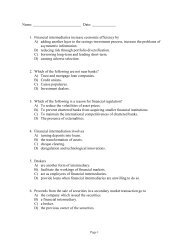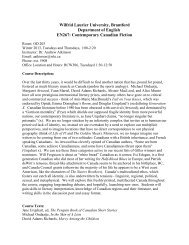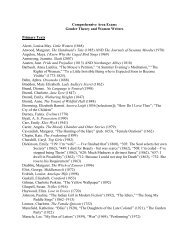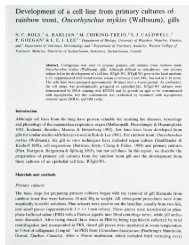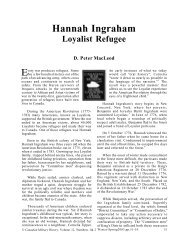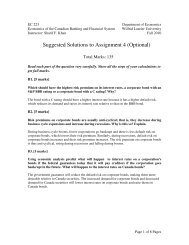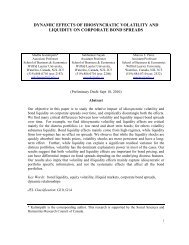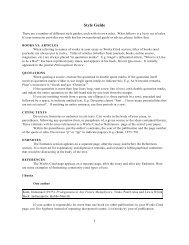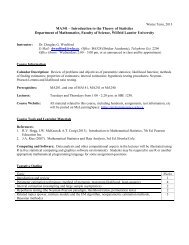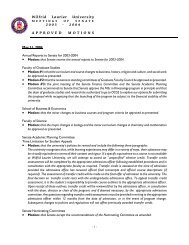Taxonomy of the Polygonum douglasii (Polygonaceae ... - WLU
Taxonomy of the Polygonum douglasii (Polygonaceae ... - WLU
Taxonomy of the Polygonum douglasii (Polygonaceae ... - WLU
Create successful ePaper yourself
Turn your PDF publications into a flip-book with our unique Google optimized e-Paper software.
18 BRITTONIA<br />
[VOL. 57<br />
cullate, naviculate to obscurely so, overlapping,<br />
green with narrow white or pink margins,<br />
midveins thickened, unbranched; perianth<br />
lobe cells are irregularly shaped, 35–<br />
45 � 10–16 �m with <strong>the</strong> anticlinal walls<br />
moderately sinuate; epicuticular wax pattern<br />
<strong>of</strong> type 1, with a dense pattern <strong>of</strong> reticulate<br />
and intertwined rodlets (Fig. 5E).<br />
Stamens 8; an<strong>the</strong>rs purple, 120–165 �m.<br />
Pollen <strong>of</strong> subtype A2, 26–28.2 �m (Fig.<br />
6E). Achenes elliptic to ovate, 1.8–2.3 mm,<br />
enclosed in <strong>the</strong> perianth at maturity, or only<br />
with <strong>the</strong> tip exserted, smooth.<br />
Although obviously related to P. <strong>douglasii</strong>,<br />
<strong>the</strong> specific status <strong>of</strong> P. minimum has<br />
never been questioned as it has been for<br />
o<strong>the</strong>r similarly related species. The morphology<br />
<strong>of</strong> an<strong>the</strong>rs and pollen place P. minimum<br />
in close relationship to P. sawatchense<br />
subsp. oblivium, P. <strong>douglasii</strong>, P. engelmannii<br />
and P. austiniae. Some forms<br />
with narrow leaves approach P. nuttallii,<br />
with which P. minimum shares a common<br />
morphology <strong>of</strong> stems, ocreae, papillae, and<br />
pattern <strong>of</strong> epicuticular wax sculpture <strong>of</strong><br />
perianth lobes. However, leaves <strong>of</strong> P. minimum<br />
are not glaucous adaxially, <strong>the</strong> margins<br />
are plane and denticulate-papillose, <strong>the</strong><br />
flowers are mostly closed, and <strong>the</strong> pollen<br />
belongs to type A.<br />
Distribution and ecology. Canada (Alberta,<br />
British Columbia) and <strong>the</strong> United<br />
States (Alaska, California, Colorado, Idaho,<br />
Montana, Nevada, Oregon, Utah, Washington,<br />
and Wyoming). It grows in alpine to<br />
subalpine communities, on open or semibarren<br />
soil; 1500–3300 m.<br />
Phenology. Flowering July–September.<br />
7. POLYGONUM NUTTALLII Small, Monogr.<br />
<strong>Polygonum</strong> 132, pl. 53. 1895. <strong>Polygonum</strong><br />
intermedium Nutt. ex S. Watson,<br />
Proc. Amer. Acad. Arts 17: 378. 1882.<br />
<strong>Polygonum</strong> <strong>douglasii</strong> subsp. nuttallii<br />
(Small) J. C. Hickman, Madroño 31: 250.<br />
1984. TYPE: UNITED STATES. Oregon<br />
(County not given). On bluffs <strong>of</strong> Columbia<br />
River, Oct 1891, Pringle s.n. (LEC-<br />
TOTYPE, here designated: GH; ISOLECTO-<br />
TYPE: NY).<br />
Annual herbs. Stems (5–)10–35 cm long,<br />
4-angled, purplish, wiry, sometimes zig-<br />
zagged, simple or branched, spreading to<br />
erect, scaberulous-papillose on and between<br />
<strong>the</strong> ribs (Fig. 1F); papillae red, orange or<br />
sometimes white, patent or retrorse, conical<br />
with a swollen base, 40–60 �m. Leaves:<br />
basal leaves persistent at flowering, evenly<br />
distributed or crowded at branch tips, gradually<br />
transformed into bracts; ocreae 3–4<br />
mm long, funnelform, scaberulous-papillose,<br />
free part finally lacerate; blades linear<br />
to narrow-elliptic, 8–30 � 1–4(–7) mm, �<br />
glaucous adaxially; margins revolute,<br />
smooth; apex acute or acuminate. Papillae<br />
on ocreae are <strong>of</strong>ten retrorse, similar to those<br />
on <strong>the</strong> stems (Fig. 1F). Inflorescences terminal,<br />
spiciform, dense and bracted; cymes<br />
with 2–3 flowers, aggregated at <strong>the</strong> apices<br />
<strong>of</strong> branches; bracts much longer than <strong>the</strong><br />
flowers <strong>the</strong>y subtend. Flowers semiopen or<br />
closed; pedicels erect or patent, 2–3 mm;<br />
perianth 1.8–2.4 mm; tube 25–33% <strong>of</strong> <strong>the</strong><br />
perianth length, perianth lobes petaloid, cucullate,<br />
usually naviculate only in <strong>the</strong> upper<br />
1/4, � overlapping (Fig. 3C), pinkish green<br />
with pink borders, midvein greenish, unbranched;<br />
perianth lobe cells rectangular or<br />
irregularly shaped, 35–45 � 10–16 �m<br />
with anticlinal walls moderately sinuate;<br />
epicuticular wax pattern <strong>of</strong> type 1, with a<br />
dense pattern <strong>of</strong> reticulate and intertwined<br />
rodlets (Fig. 5F). Stamens 8; an<strong>the</strong>rs purple,<br />
250–325 �m. Pollen <strong>of</strong> type B, 27–29.2 �m<br />
(Fig. 6F). Achenes elliptic to ovate, 1.8–2.3<br />
mm, enclosed in perianth at maturity,<br />
smooth.<br />
<strong>Polygonum</strong> intermedium is illegitimate<br />
being a latter homonym for which Small<br />
(1895) proposed a new name, P. nuttallii.<br />
The collection designated as a lectotype<br />
was first quoted by Hitchcock (1964). Hickman<br />
(1984) considered that Hitchcock effectively<br />
lectotypified <strong>Polygonum</strong> nuttallii.<br />
However, in Vascular Plants <strong>of</strong> <strong>the</strong> Pacific<br />
Northwest, no names were typified unless<br />
specifically stated (Hitchcock et al., 1957).<br />
To eliminate any doubt, <strong>the</strong> lectotype was<br />
formally designed here.<br />
This distinct but uncommon species has<br />
been combined with P. <strong>douglasii</strong> (Hickman,<br />
1984) because it was considered a<br />
small-flowered form <strong>of</strong> P. spergulariiforme,<br />
as previously suggested by Hitchcock<br />
(1964). Although similar to P. spergulari-



